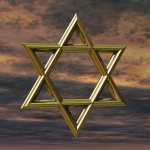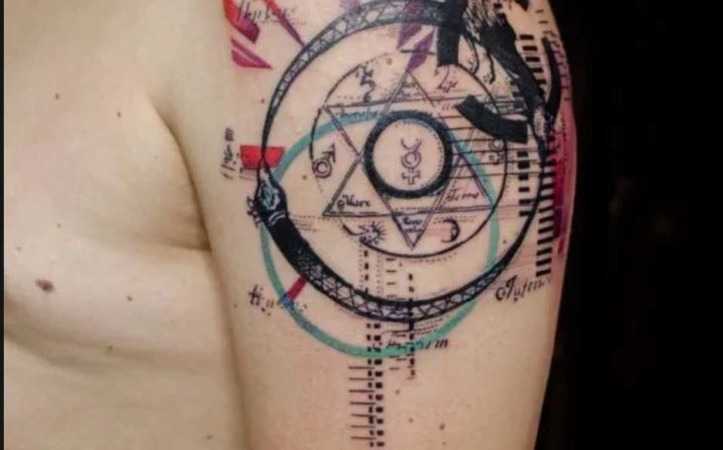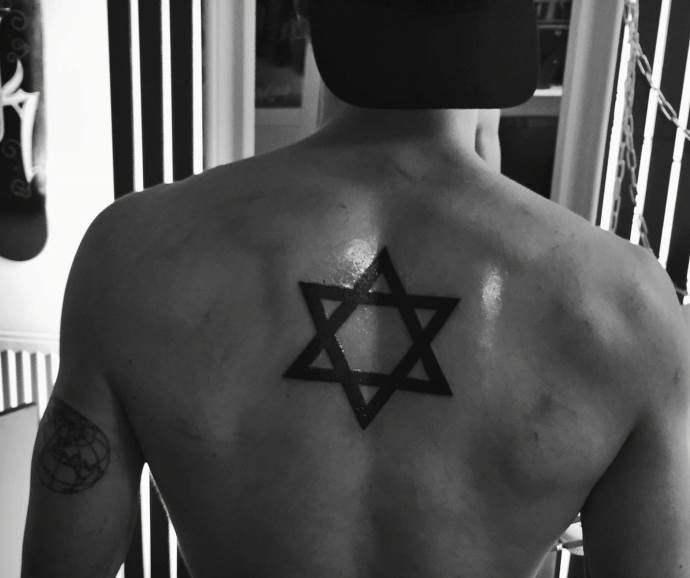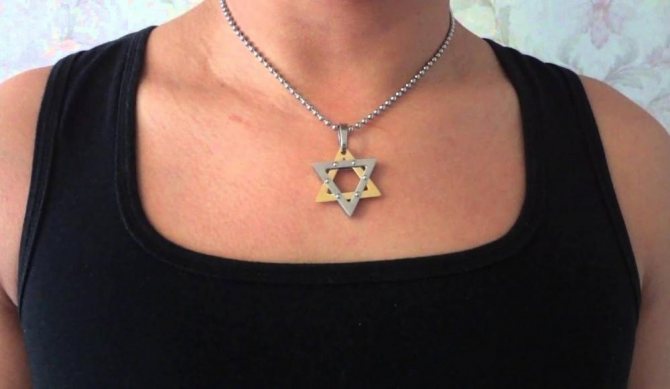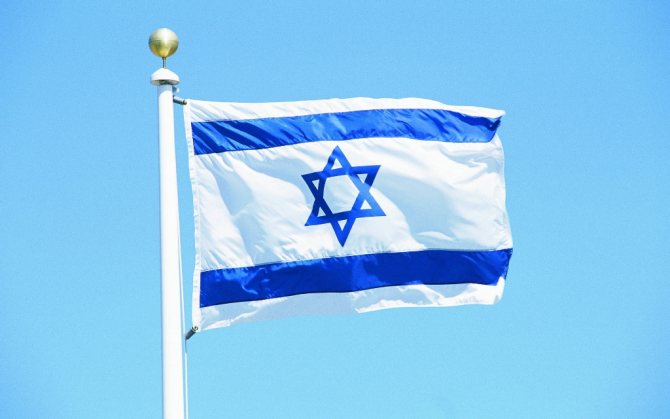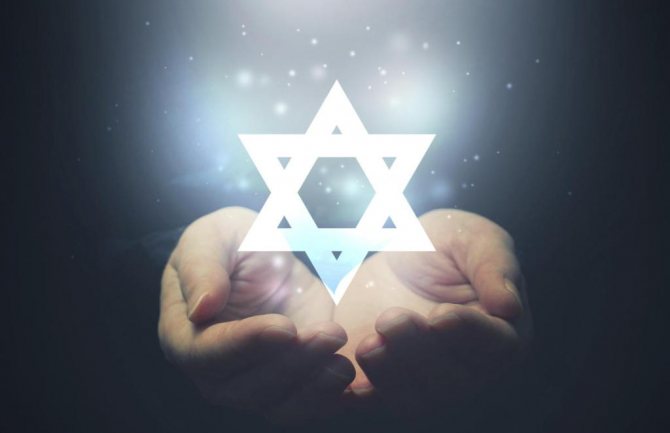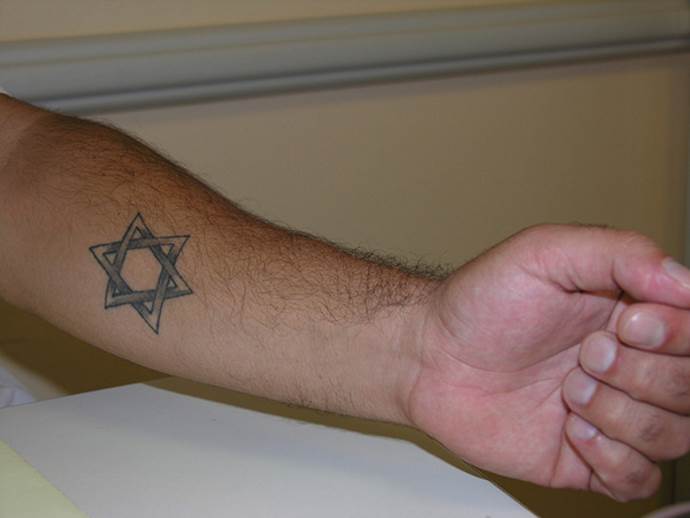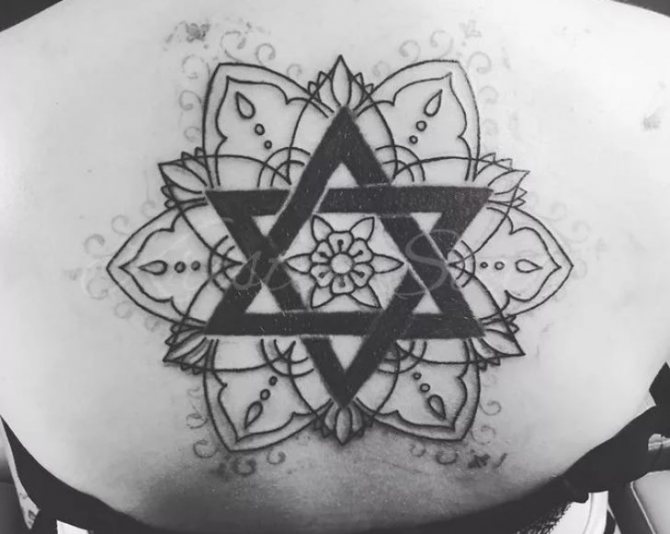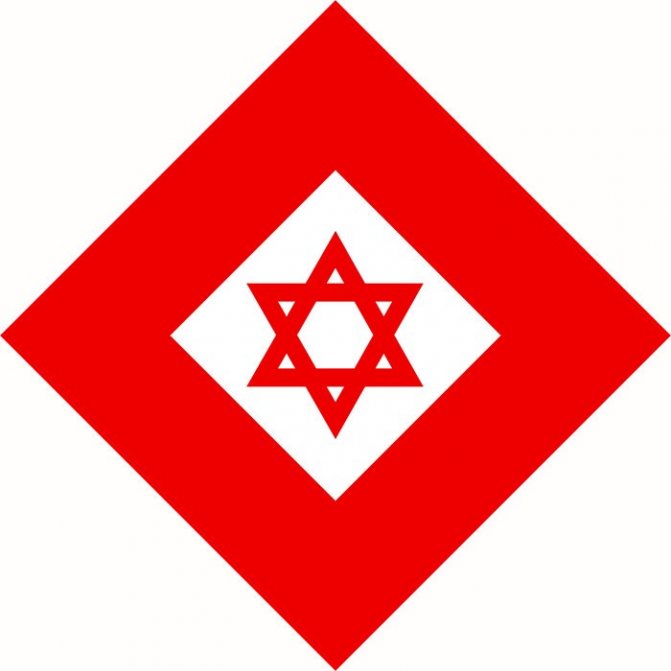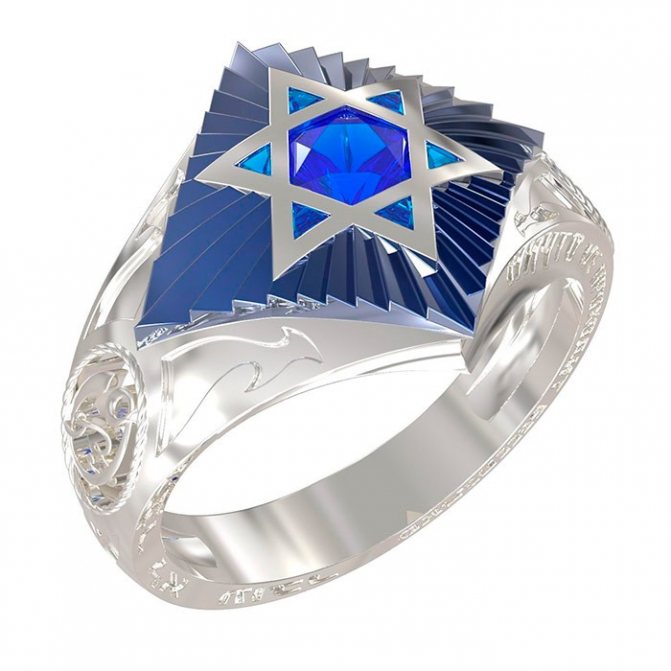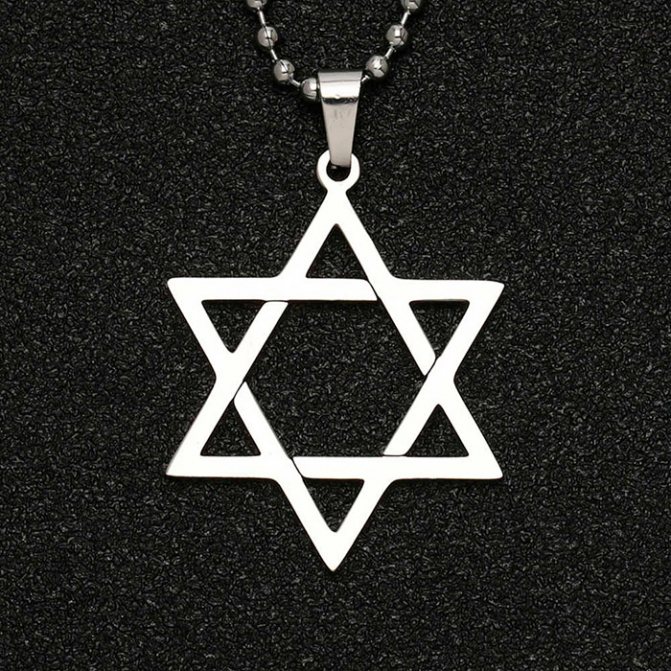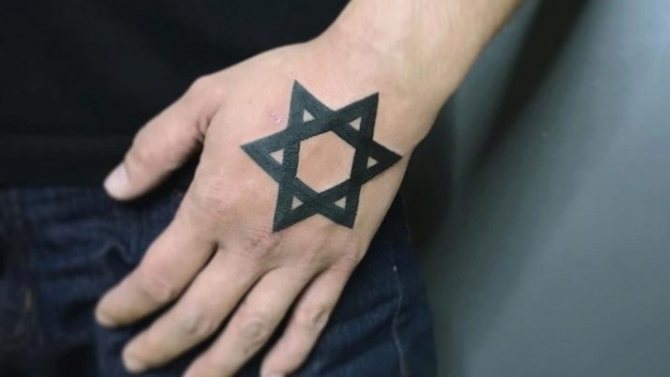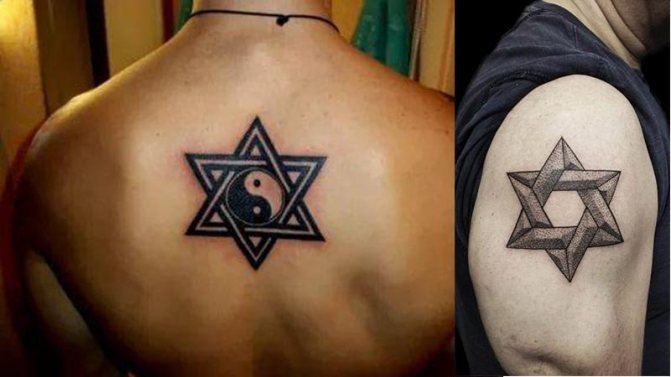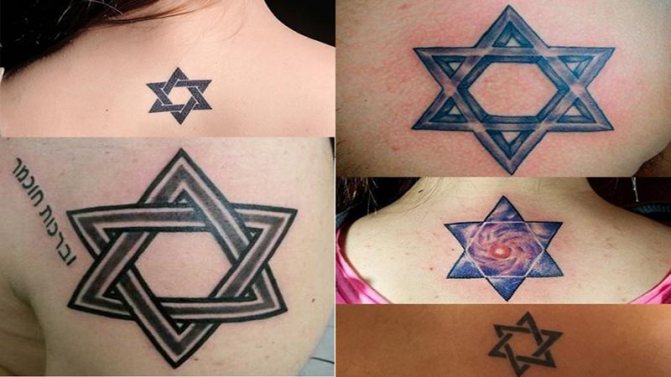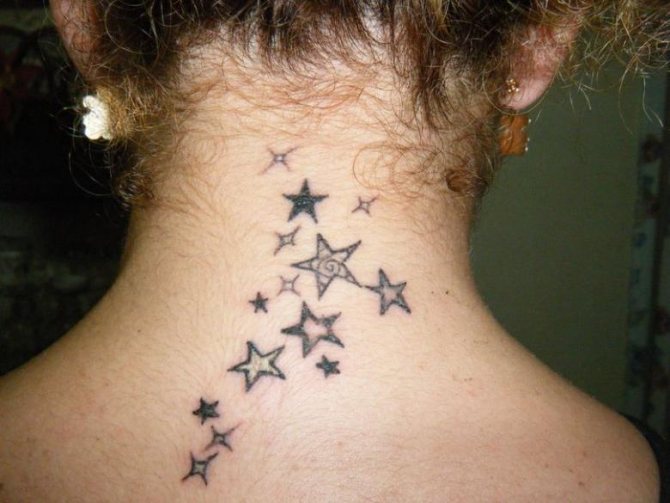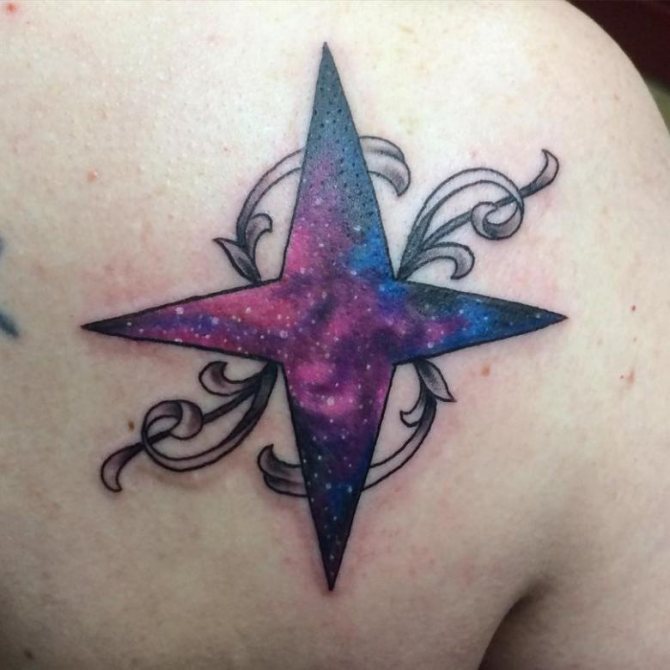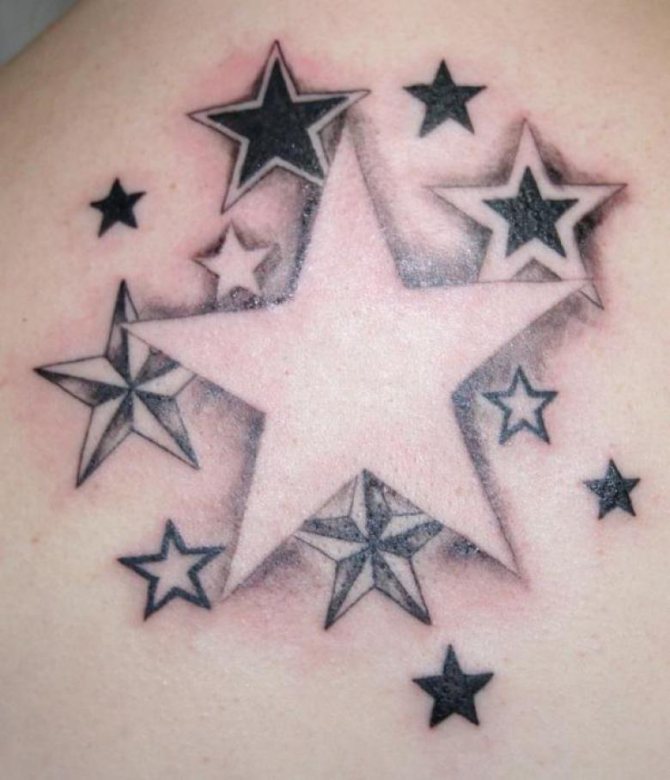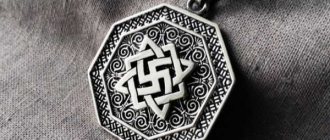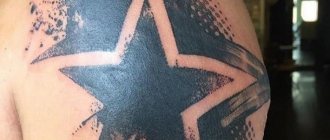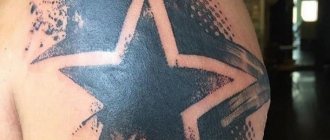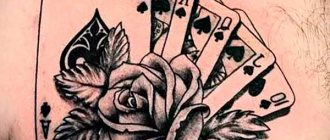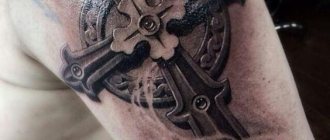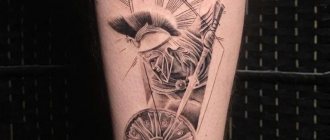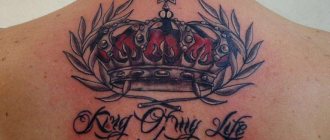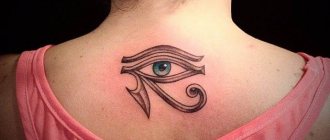Today we will talk about the sign that symbolizes the interaction of human nature with the divine. The meaning of the Star of David tattoo is often equated with the Eastern yin and yang, which is the unity of opposing energies to create harmony. However, in fact, there are many more interpretations of the symbol. For some, it is a protective amulet, for others - the embodiment of the sides of light and the elements. But most often, this mystical, intriguing symbol is associated with Judaism.
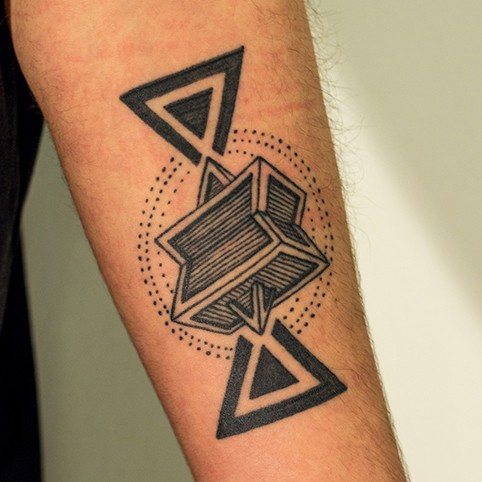
A person with such a drawing will always be under the protection of God, but it does not mean permissiveness. On the contrary, this image imposes a lot of obligations, because from now on, the bearer is always in sight, and for all bad actions will have to answer, sometimes even more severely than before.
It is not worth the risk, and choose this sketch, if you have nothing to do with religion. At best, you just won't be understood. At worst, a chance encounter with neo-Nazis will be remembered for a long time. For them you are a "Jew," and therefore a new target. They, believe me, are not at all interested in what the Star of David tattoo actually means. Even Jews avoid this image for tattoos because of its specific energy and shadow of the past.
In some circles, the meaning of the tattoo Star of David has a negative connotation. There is an opinion that black magicians often use this symbol in their practices. However, this statement is not entirely true. One thing is certain - this image has great power, and if you use it wisely, nothing bad will happen.
Jews and Asians: everyone has his own David
The Star of David or Solomon's Seal is most often associated with the birth of the Jewish religion and culture. Surviving written records, narratives and legends reveal the great significance of David in shaping the mentality of the Jewish people. But the same importance is given to the hexagonal star by the Chinese. For them, it is a symbol of union of male and female principles of yin and yang. And the hexagonal star never acted as a negative. But by definition, it demanded the highest moral actions. From this point of view, the Star of David selected for the tattoo can testify to the moral principles of the one who chose it. No one keeps official statistics, but there is reason to believe that this image is worn by a person with faith in his soul and moral principles.
History of the origin of the symbol
In the same way, you must have the power to make a decision and the right to make a decision. In this case, it is executed not in the form of a single line, but of two equivalent triangles, which are superimposed on each other. The apex of one looks downward, the other upward. The star is known by other names:
- Shield of David;
- Magen David;
- Mogendovid;
Also read about another version of the Star of David, the Seal of King Solomon.
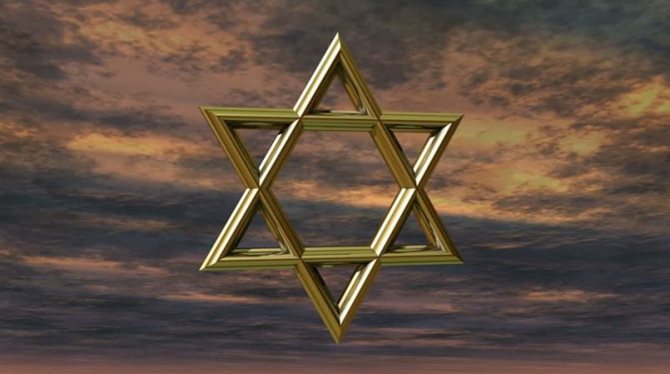

David was the second Jewish king who ruled, according to various accounts, in the 10th-9th centuries BC. David was the epitome of the ideal sovereign, uniting Israel and Judea. He is believed to have been blessed by God to reign. According to some theories, the symbol did not belong to David, but to his son, Solomon.
The first unambiguous image of a similar sign dates from the 7th century B.C. It was present on a seal found in Lebanon. However, there is evidence that such a star was present on the wall of a 9th century building. B.C., but the drawing was unclear and not subject to a single interpretation.
Even before its appearance in the Middle East, the star was used in India as a symbol of the Anahata chakra. Early depictions of the star had no religious or mystical significance, it was a purely decorative element.
Hexagrams became widespread in the 4th-1st centuries B.C., when they began to draw it on various utensils, crockery, stamps, building walls and lamps.
At the same time hexagram was present simultaneously in different parts of the world and, according to scientists, was not borrowed from neighbors, but appeared independently of each other. At the boundary of the eras the meaning of the symbol did not change - it was a decorative element, but more often became present in the architecture and ornaments of interior decoration, especially of religious buildings. For example, the mogendoid can be found in:
- Hebrew Temples (516-348 B.C.).
- The synagogue at Capernaum (2nd-3rd century A.D.).
- Villa of a Roman general in Ein Ejala.
In the Middle Ages hexagram was used by citizens of the Old World, Arabs, as well as by Jews and Muslims. It was present on the seals of various religions, alchemical texts, and the ornaments of buildings, especially religious ones. For example, the star is present in the decorations:
- The Cathedral in Burgos, Spain.
- The Christian church in Tiberias (Israel).
- A religious building in Anagni (Italy).
- The synagogue of Hameln (Germany).
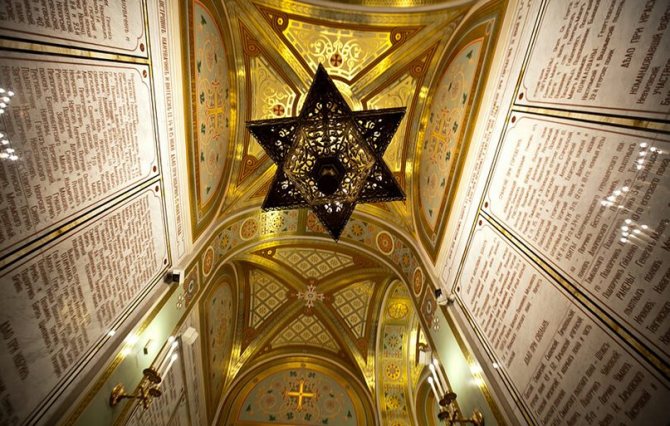

Also in the Middle Ages the name "Shield of David" is first used in literature interpreting the alphabet of the angel Metatron. It was assumed that it carried the name of God on it. The hexagram is also represented in the 14th century text. "Sefer ha-Gvul, where it carries a similar purpose. Around the same time, the star begins to appear on amulets, in mystical writings, and in works on Kabbalah.
The first attachment to an exclusively Jewish sign occurred in 1354, when the local representatives of the community in Prague were granted the right to their own flag, a seal. All attributes were adorned with the Magen David star.


Subsequently, it was from the Czech Jews that the hexagram as a symbol of the people was spread. It was used as a typographic sign in books, an element of coats of arms, decoration inside synagogues and religious utensils. Later the star began to be used with a similar meaning among the Jews of Austria, Italy, the Netherlands, and later in Eastern Europe.
At this time, the hexagram was called both "David's Shield" and "King Solomon's Seal." The latter name was later relegated to the five-pointed symbol, although adherents of the Kabbalah believe otherwise. The Shield of David for them is an appurtenance of his son, Solomon. They often decorate the hexagram with letters forming the phrase "Messiah, son of David.
Since the late 18th and early 19th centuries, the symbol is unequivocally enshrined as a sign of Jewishness. It is applied to tombstones, is present on the coats of arms of wealthy families, in synagogues, letterheads, seals, and household items.
Since 1897 the Zionists approved the "flag of the State of Israel" with a blue hexagram on a white background. It was later enshrined as the official government flag.
What the Star of David means in different cultures
Despite the fact that the first purpose of the mogendovid was decorative, later it has changed significantly, depending on the belonging of the inhabitants to a particular culture or religion.
The main variants of interpretation:
- In Hinduism. - The embodiment of "Anahata." This chakra is depicted as a hexagram with lotus petals around, a total of 12 of them are represented. Meditation on Anahata makes one clairvoyant, aware of the past, present and future, immortal, wise, noble, attractive in the eyes of the opposite sex, and an excellent orator.
- In oriental practices. - the unity of the masculine and feminine. Triangle, directed downward pointing top symbolizes the energy of Yang, upward - Yin.
- In Judaism. - the six petals of the lily. This flower, blossoming, forms a figure similar to a hexagram. The white lily, in turn, represents the Jewish people.
- The actual shield of King David's warriors. According to some theories, the hexagram is believed to be a monogram of the ruler's name (in the old manner, the letter "e" represented a triangle). Warriors put the sign on shields (according to other data used metal crosshairs in the form of such a figure as the basis for a protective object).
- Commonality of the elements.
- The designation of belonging to the Jews (for Nazis).
- The 12 tribes of Israel. The tribes of the descendants of the sons of Jacob, stopping along the way during the years of wandering, formed a six-pointed star with their tents.
- Unity of the Universe.. The triangle pointing upwards symbolized the cosmos and the heavenly beginning (or spirituality), with the top pointing downwards - the earthly and microcosm (as well as the human essence).
- The commonality of primordialities for religious currents. The vertices represent the sides of the world, heaven and earth.
- Several Sfirot (for Kabbalists). These are "beauty", "grace", "eternity", "kingdom", "glory", "austerity", and the central figure is "foundation".
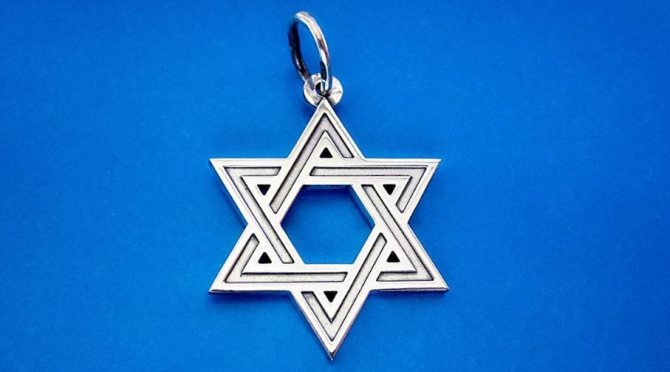

The tattoo is not for public view
This definition absolutely fits the Star of David tattoo. Today, the classic places for it have already been determined: it is the back or The upper arm, shoulder and forearm. So emphasizes a special, respectful attitude to everything that stands behind this sign. On the Internet you can find quite a lot of works with the image of the star between the shoulder blades.
When choosing where to work with this symbol, a professional performer will definitely tell you where to draw. And then the details can be stipulated - color and shade, size, density, etc. The main thing is that the symbol does not offend the meaning, does not violate the sacred meaning.
More on this topic: pictures of tattoos on the neck for girls
Meaning in Christianity
In addition to Jewish culture, the sign in question is often found in Christianity. It is often referred to as the star of the Creator, as it symbolizes the Star of Bethlehem, which pointed the way to the birthplace of the messiah.
The image was enshrined in the mosaics of Orthodox churches and symbolized the struggle of God with the Devil, as well as the unity of human and divine forces.
In addition, Christians saw in the star a model of the universe, for the reason that the Earth was created exactly in six days. However, there were also those who were wary of this image because they associated it with the number of the beast because of the six sides and angles in the figure.
Beware: the symbolism of Satanism
Another proof that depicting the Star of David on the body should be a master. Both as an artist and as a kind of educator. Otherwise, there can be just the opposite effect: it is enough to turn the pentagram so that the tattoo is perceived as both a slogan and a sign of Satanism. It is considered the most powerful and most evil personification of Satan. It is still used in the ritual of summoning the spawn of Hell.
To meet a Satanist with an inverted pentagram in his outfit is far more common today than it was a couple of decades ago. So it will be a meeting with someone who in his mind and lifestyle is guided only by animal instincts.
In order not to even accidentally find yourself in such a company, it is better not to make a mistake with the choice of a competent tattoo master.
Stars of Heaven
Sparkling with the multi-colored far flames of the night sky at all times has caused admiration and fascination. Very effective look "shooting stars", casting a romantic and sublime mood. Under the stars people used to dream, make love declarations and indulge in philosophical reflections. And the shooting stars have long been making wishes and hoping that they will come true.
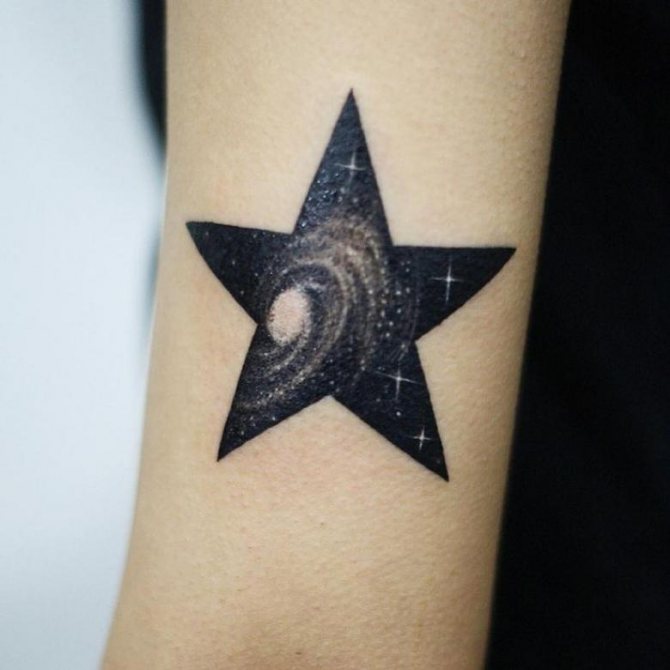

Ancient sailors and travelers used the stars as their guide.


Identified among the myriads of shining points of his "guiding star", it was possible to reliably move to the intended place.
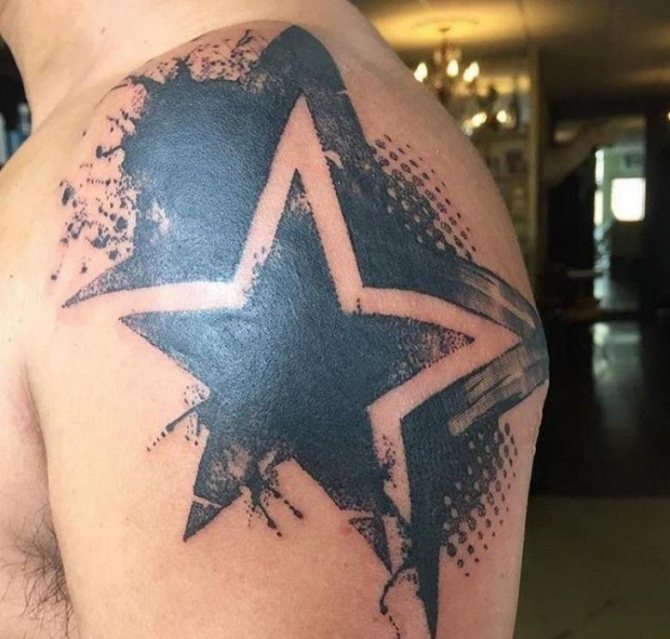

A photo of the Star of David tattoo on the body
Literature
In English
- Dr. Asher Eder, "The Star of David".
- G.S. Oegema, Realms of Judaism. "The history of the Shield of David, the birth of a symbol" (Peter Lang, Germany, 1996) ISBN 3-631-30192-8
- Gershom Scholem.
The curious history of the six-pointed star // Commentary. - 1949. - № 8. - P. 243-251.
In Hebrew
- אורי אופיר.
(Hebrew). Moreshet.co.il. Accessed October 1, 2012. - אפרים דיינרד, ציון במשפט.
. - הדבורה
שנת תרמ "ה גיליון 33 וגיליון 40. - ישראל יפה, האסיף
תרמ "ו. - המליץ
תרנ "ח גיליון 11. - תל תלפיות
תרס "א, עמ' 164 ועמ' 183. - מיכאל קוסטא, חתך הזהב, חותם שלמה ומגן דוד
, ספרית פועלים, 1990. - אורי אופיר, "הסמל," הוצאת ספר לכל, 2001
- אורי אופיר, "הדגל," הוצאת ספר לכל, 2002
- אליק מישורי, "שורו הביטו וראו", איקונות וסמלים ציוניים בתרבות הישראלית, עם עובד
Star of David tattoo photo on your arm
5/5 - (4 votes)
Examples of modern images
In state symbols.
- The flag of Israel.
- U.S. state symbols, such as the Great Seal of the United States (in its first version), contain a six-pointed star in various modifications.
- Coats of arms of German cities: six-pointed and six-rayed stars are included in the coats of arms of the cities of Scher, Hamburg and Herbstedt (the latter represents the classical Star of David).
- Coats of arms of Ukrainian cities - Poltava, Ternopil, Konotop and Energodar.
- Coat of Arms of the Portuguese city of Covillian.
- Coat of arms of the Russian city of Kolomna.
- Coat of Arms of Croatia: six-pointed stars on two of the five prongs of the crown, symbolizing parts of the kingdom (in the past), Croatia proper and Croatian Dalmatia.
- Flag of Burundi: three six-pointed stars represent the national motto: "Unity. Work. Progress."
- Colonial flag of Nigeria (1914-1960).
- Two six-pointed stars were placed at the bottom of the .
- The unofficial flag of Northern Ireland, as well as the flag of Northern Irish separatists, includes a red hand on the background of a six-pointed star, symbolizing, according to one interpretation, the six counties of Ulster (on the flag of the British governor of Northern Ireland it is an element of the heraldic shield, on the "Ulster banner" - an independent central symbol).
- In the coats of arms of Finnish municipalities and towns: the municipalities of Muonio, Pello and Sodankylä in Lappi, Lapinlahti in the province of Northern Savo, Hämeenkürö in Pirkanmaa, Kannus in Central Ostrobothnia, Sauvo and Koski in Varsinais-Suomi, Karjalohja in Uusimaa, Haussjärvi in Kanta-Häme, as well as in the province's coat of arms. In addition, the six-pointed star is present on the coat of arms of the town of Hanko (Gangut).
- In Estonia, it appears on the coat of arms of Haaslava parish in Tartumaa county, as well as on the coat of arms of the county itself. On the coat of arms of Avinurme parish, Ida-Virumaa county, as well as on the coat of arms of Rakvere (Wesenberg)
- In Sweden on the coat of arms of Ronneby of Blekinge, Brekke of Jemtland, Kalmar of the same name, Arvidsjaur and Everturneo of Norrbotten, Wallentuna and Sigtuna of Stockholm, Arbuga of Westmanland, Lusekil of Västra-Götaland and on the coat of arms of the county. The municipalities of Edesshög and Söderköping in Östergötland and Örebro in the county of the same name. In addition, the six-pointed stars are present on the coat of arms of Westerbotten County and the city of Sigtuna.
- The coat of arms of Krasnodar is surrounded by a green border with 59 gold six-pointed stars.
Examples of modern depictions
State symbols
- Flag of Israel.
- U.S. state symbols, such as the Great Seal of the United States (in its first version), contain a six-pointed star in various modifications.
- Coats of arms of German cities: six-pointed and six-rayed stars are included in the coats of arms of the cities of Scher, Hamburg and Herbstedt (the latter represents the classical Star of David).
- Coats of arms of Ukrainian cities - Poltava, Ternopil, Konotop and Energodar.
- Coat of Arms of the Portuguese city of Covillian.
- Coat of arms of the Russian city of Kolomna.
- Coat of Arms of Croatia: six-pointed stars on two of the five prongs of the crown, symbolizing parts of the kingdom (in the past), Croatia proper and Croatian Dalmatia.
- Flag of Burundi: three six-pointed stars represent the national motto: "Unity. Work. Progress."
- Colonial flag of Nigeria (1914-1960).
- Two six-pointed stars were placed at the bottom of the .
- The unofficial flag of Northern Ireland, as well as the flag of Northern Irish separatists, includes a red hand on the background of a six-pointed star, symbolizing, according to one interpretation, the six counties of Ulster (on the flag of the British governor of Northern Ireland it is an element of the heraldic shield, on the "Ulster banner" - an independent central symbol).
- In the coats of arms of Finnish municipalities and towns: the municipalities of Muonio, Pello and Sodankylä in Lappi, Lapinlahti in the province of Northern Savo, Hämeenkürö in Pirkanmaa, Kannus in Central Ostrobothnia, Sauvo and Koski in Varsinais-Suomi, Karjalohja in Uusimaa, Haussjärvi in Kanta-Häme, as well as in the province's coat of arms. In addition, the six-pointed star is present on the coat of arms of the town of Hanko (Gangut).
- In Estonia, it appears on the coat of arms of Haaslava parish in Tartumaa county, as well as on the coat of arms of the county itself. On the coat of arms of Avinurme parish, Ida-Virumaa county, as well as on the coat of arms of Rakvere (Wesenberg)
- In Sweden on the coat of arms of Ronneby of Blekinge, Brekke of Jemtland, Kalmar of the same name, Arvidsjaur and Everturneo of Norrbotten, Wallentuna and Sigtuna of Stockholm, Arbuga of Westmanland, Lusekil of Västra-Götaland and on the coat of arms of the county. The municipalities of Edesshög and Söderköping in Östergötland and Örebro in the county of the same name. In addition, the six-pointed stars are present on the coat of arms of Westerbotten County and the city of Sigtuna.
- The coat of arms of Krasnodar is surrounded by a green border with 59 golden six-pointed stars.
Notes
- ↑ Gershom Scholem.
(English.). Jewish Virtual Library. Accessed September 17, 2012. - ↑
- (Hebrew). Star-of-david.blogspot.ca (7.06.2009). Accessed October 2, 2012.
- ↑ - article from
- - article from
- , p. 247.
- Magen David // The Jewish Encyclopedia of Brockhaus and Efron. - St. Petersburg, 1908-1913.
- , pp. 246-247.
- ↑ , p. 246.
- David Alroy.
. Judaism and the Jews (from Torah World magazine) (April 15, 2010). Accessed October 1, 2012. - , pp. 248-249.
- , p. 250.
- , p. 251.
- ↑ (English). Aish.com. Accessed October 18, 2012.
- - article from
- Melnikov, D. E., Chernaya, L. B.
Death Conveyor // The Empire of Death: The Apparatus of Violence in Nazi Germany. - Moscow: Politizdat, 1987. - (ed.). The New York Times (September 18, 1919). Accessed October 18, 2012. (English). Adoptiegraven.nl. Date of access October 18, 2012. (In Russian.) The Long, Long Trail: The British Army in the Great War. Accessed October 18, 2012.
- Alec Mishory.
(The Long Trail: The British Army in the Great War.) Israel Ministry of Foreign Affairs (April 28, 2003). Accessed September 28, 2012. - Isabel Kershner.
(In: The New York Times.)
The New York Times
(February 8, 2007). Accessed October 18, 2012. - ↑ Jonah Newman.
(In: Jonah Newman.)
The Jerusalem Post.
(August 17, 2009). Date of accession: October 18, 2012. - ↑ - article from
- . NEWStu.co.il (June 22, 2006). Date of reference September 28, 2012.
- Eliyahu Essas.
. Evrey.com (January 21, 2003). Accessed October 16, 2012. - Naftali Silberberg.
(in English). Chabad.org. Date of accession on October 16, 2012. - Gabriel H. Cohen.
(in English). Bar-Ilan University (1998). Accessed on October 4, 2012. - - article from
- (English). Heraldry of the World. Accessed on October 18, 2012. (German). Hamburg.de. Date of accession on October 18, 2012. (in Russian). Heraldry of the World. Date of accession on October 18, 2012.
- . Heraldika.ru. Date of accession October 18, 2012. Heraldicum. Date of access October 18, 2012. Heraldica.ru. Date of access on the 18th of October 2012.
- Alfred Znamiersky.
The Flags of the World. - Moscow: BMM, 2002. - С. 98. - ISBN 5-88353-150-4.
Notes
- ↑ Gershom Scholem.
(English). Jewish Virtual Library. Date of accession September 17, 2012. - ↑
- (Hebrew). Star-of-david.blogspot.ca (7.06.2009). Accessed October 2, 2012.
- ↑ - article from
- - article from
- , p. 247.
- Magen David // The Jewish Encyclopedia of Brockhaus and Efron. - St. Petersburg, 1908-1913.
- , pp. 246-247.
- ↑ , p. 246.
- David Alroy.
. Judaism and the Jews (from Torah World magazine) (April 15, 2010). Accessed October 1, 2012. - , pp. 248-249.
- , p. 250.
- , p. 251.
- ↑ (English). Aish.com. Accessed October 18, 2012.
- - article from
- Melnikov, D. E., Chernaya, L. B.
Death Conveyor // The Empire of Death: The Apparatus of Violence in Nazi Germany. - Moscow: Politizdat, 1987. - (ed.). The New York Times (September 18, 1919). Accessed October 18, 2012. (English). Adoptiegraven.nl. Date of access October 18, 2012. (In Russian.) The Long, Long Trail: The British Army in the Great War. Accessed October 18, 2012.
- Alec Mishory.
(The Long Trail: The British Army in the Great War.) Israel Ministry of Foreign Affairs (April 28, 2003). Accessed September 28, 2012. - Isabel Kershner.
(In: The New York Times.)
The New York Times
(February 8, 2007). Accessed October 18, 2012. - ↑ Jonah Newman.
In: Jonah Newman (ed.).
The Jerusalem Post
(August 17, 2009). Accessed October 18, 2012. - ↑ - article from
- . NEWStu.co.il (June 22, 2006). Date of accession September 28, 2012.
- Eliyahu Essas.
. Evrey.com (January 21, 2003). Accessed October 16, 2012. - Naftali Silberberg.
(in English). Chabad.org. Date of accession on October 16, 2012. - Gabriel H. Cohen.
(in English). Bar-Ilan University (1998). Accessed on October 4, 2012. - - article from
- (English). Heraldry of the World. Accessed on October 18, 2012. (German). Hamburg.de. Date of accession on October 18, 2012. (in Russian). Heraldry of the World. Date of accession on October 18, 2012.
- . Heraldika.ru. Date of accession October 18, 2012. Heraldicum. Date of access October 18, 2012. Heraldica.ru. Date of access on the 18th of October 2012.
- Alfred Znamiersky.
The Flags of the World. - Moscow: BMM, 2002. - С. 98. - ISBN 5-88353-150-4.
